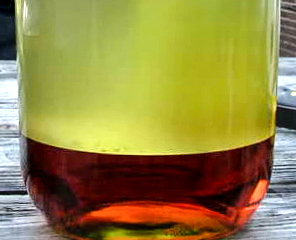Water in a fuel storage tank is a disaster waiting to happen and removing it has never been an easy task. Enter the H2Out fuel and water separator sock – it’s simple and affordable, so there’s no reason not to keep some spares on hand.

Water in fuel: The dangers and how to get rid of it
Water in fuel is something we regularly experience living in Australia. With the colder weather upon us, we have heard numerous complaints from concerned customers about the damage this has caused to expensive equipment.
Winter brings its own problems!
During winter, warm engines cause the humid air in fuel tanks to condense, which in turn causes water to accumulate inside.
Above-ground fuel tanks are also susceptible to water accumulation as temperatures drop overnight. Lower ambient temperatures lower the water solubility point, resulting in any water (contained within the fuel) to ‘drop out’ of the fuel and again accumulate in the fuel tank.
Also during winter, rain can seep into tanks and engines if they are not properly sealed or maintained.
The damaging effects of water in fuel
Any water in your fuel tank will create severe problems with fuel injectors and may result in them exploding. Importantly, larger slugs of water induced into the fuel supply may result in severe damage to an engine as water will not compress in an engine cylinder. This can also cause an engine to cool too quickly and potentially crack core components.
Bacteria and fungus also breed in water. As these microbes multiply over time, they produce acids which affect fuel quality, clog filters and cause storage tanks to corrode.
Finally, there is the fundamental loss of power as less fuel is being pumped into the engine.
Biodiesels have the same issues
Biodiesels can have a higher potential for water-associated fuel problems due to microbe activity in the biofuel portion of the fuel. As water levels in biofuels can quickly accelerate, it is even more important to monitor water levels in biodiesel fuel tanks.
A cost-effective way to control water in fuel
If it’s possible, the easiest way to remove water from a fuel storage tanks is to simply drain the water (via a tap) from the bottom of tank. However, in many cases this is not possible, therefore filters and/or additives need to be used.
An alternative method, new to the Australian market, involves collecting water from the fuel via a sock-like filter. Aptly named H2Out, this water/fuel separation sock is a safe and cost-effective way to remove water from your fuel tank.
How it works
The H2Out sock is lowered into the fuel tank via a long stainless wire where it begins to absorb water. Although the H2Out sock starts absorbing immediately, it is recommended to leave it in-situ for 24 hours to maximise its effect. Each sock can absorb approximately 250mls of water.
For contamination of more than 250mL of water, simply use multiple bags. Please note: the minimum diameter of the fuel tank opening is 38mm for the H2Out to fit through.
Detecting water in fuel
When water is present, fuel will visually appear darker than normal. You may also see signs of microbe growth and will often smell a foul odour.
A more certain method to detect water is to use a water-finding paste such as Sar-Gel. Place a small smear of the water-finding paste onto a dip stick or similar and insert into the tank or engine for 30 seconds. In the presence of water, the paste will turn a dark scarlet colour. Sar-Gel works with most fuels, except those with ethanol over 20%.









